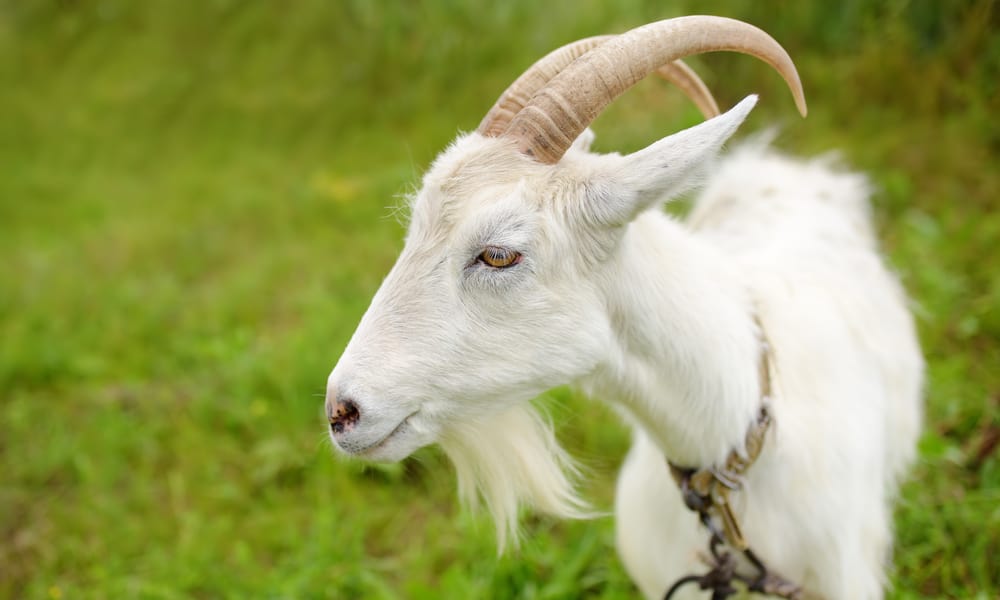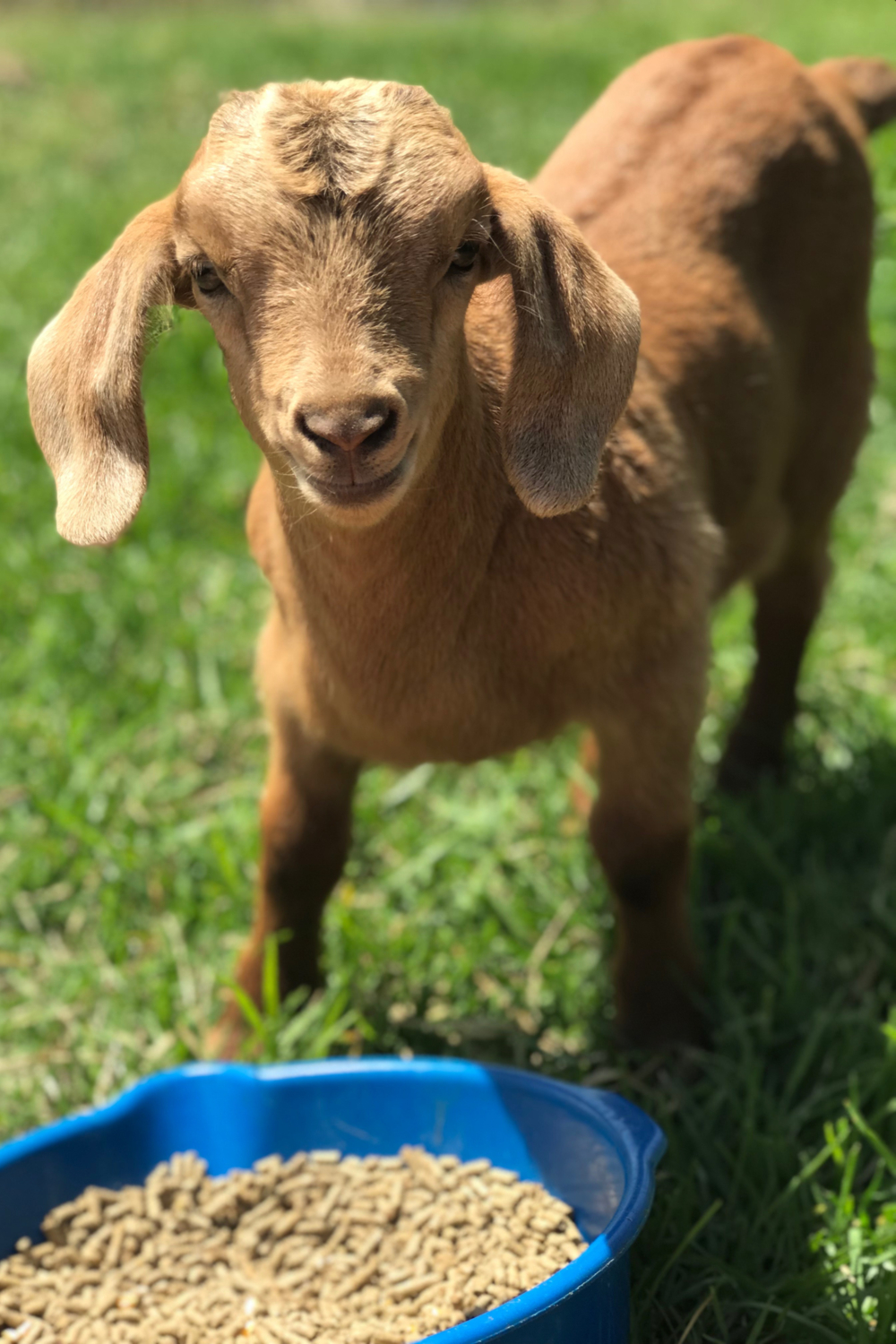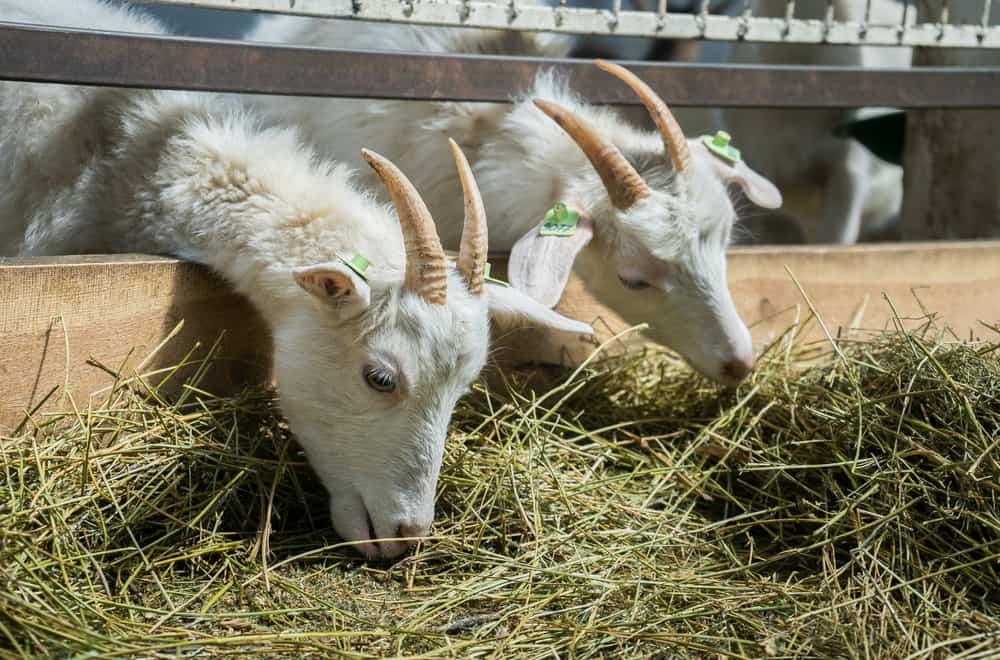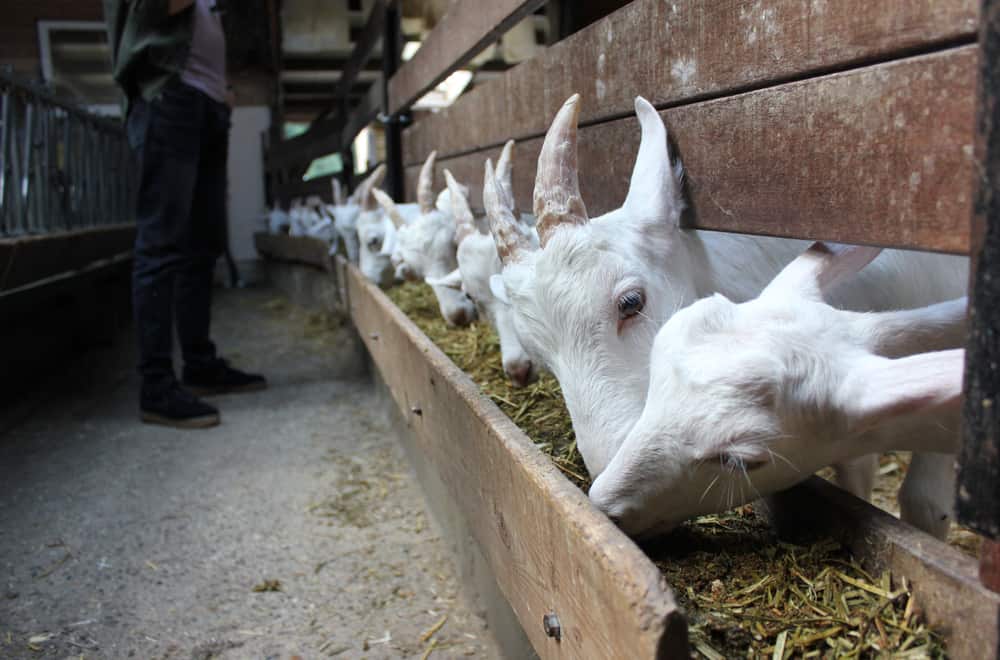There is no precise and short answer to the question of what do goats eat because they can swallow all and everything. However, you should ensure enough proteins, fats, vitamins, and minerals to these animals, depending on breed, age, and size.
Plus, it is not the same if you raise goats for meat, dairy, or only plan to practice sustainable living. The rule of thumb is that you should offer your animals numerous food types, preferably organic, and never make drastic changes to their diet all at once to prevent the bacteria imbalance in the rumen.
Goats Habits and Biology
Goats are stout-bodied mammals but also one of the smallest domesticated livestock worldwide. You can recognize two goat types:
- Mountain goats
- Domestic goats
While domestic goats have a black, chocolate, or yellow coat, mountain goats’ hair is bright white. Even though you are used to seeing calm goats, mountain goats adore jumping and can jump out of place up to an impressive 12 feet (3.5 m).
Both types can quickly adapt to almost any pasture type, putting them in a group of opportunistic animals.
Goats were domesticated 9,000 years ago, classifying them into the first domestic animals. Their meat (cabrito, chevon) is a favorite food in many countries. Believe it or not, people worldwide drink more goat milk than milk from all other animals.
Goat types |
||
| Scientific classification | Domestic goat | Mountain goat |
| Kingdom | Animalia | Animalia |
| Phylum | Chordata | Chordata |
| Class | Mammalia | Mammalia |
| Order | Artiodactyla | Artiodactyla |
| Family | Bovidae | Bovidae |
| Subfamily | Caprinae | Caprinae |
| Genus | Capra | Oreamnos |
| Species | Capra hircus | Oreamnos americanus |
Do you know that goats produce more milk than cows when you calculate based on the same nutrient quantity? The goat’s milk nutrient conversion efficiency is 45.71%, compared to an average of 38% for cow’s milk.
Goats are superior to sheep, buffaloes, and cows in crude fiber utilization. Plus, they use more useless feed than most other animals. Interestingly, they also consume 6.5 to 11% food their body weight, compared to cows and sheep that need only 2.5 to 3%.
For instance, let’s check the requirements of one goat weighing 110 pounds (50 kg) that produces 67.5 US fluid ounces (2 l) of milk with 3% to 4.5% fat. For this animal, you need to provide daily:
- 9 pounds (400 g) of concentrate
- 11 pounds (5 kg) of berseem or Lucerne
The crucial thing is that their diet should have 12% to 15% of proteins.
What Do Goats Like to Eat Most
Unlike sheep, goats prefer grazing approximately 4 to 59 inches (10 – 150 cm) tall grass. Their diet looks simple since they always prefer selecting grass, tree, and shrub leaves for their regular meals. However, they have a few weird eating habits.
Believe it or not, these creatures spend up to 60% of their active feeding time looking for food and only 40% grazing. In fact, they will often walk long distances while looking for food.
You can use them on the bush growth control, but avoid letting them inside your yard. Unlike sheep, these animals will destroy your lawn.
Goats can recognize the difference between sweet, salty, sour, and bitter taste. Surprisingly, they will show a higher tolerance for bitter food than other ruminants. Goat’s typical diet will depend on:
- Ecology
- Season
- Forages availability
- Diurnal patterns
Their daily routine looks the same to humans, including looking for food in the morning and feeding during the afternoon. However, they won’t tolerate the same meal every single day. They usually need a diverse menu that includes:
- Grass and weeds
- Forbs
- Shrubs, even unpalatable ones
- Shoots and leaves of growing plants
- Grains and crop residues
- Cereal straws
- Hay
- Beet pulp
- Chaffhaye
- Apple cider vinegar
- Extra treats, including carrots, pumpkin and sunflower seeds, greens, and raisins
Your goat will also enjoy green roughages, such as:
- Lucerne, shaftal, berseem, and senji
- Napier grass
- Cowpea, soybean, methi, and green arhar
- Cauliflower and cabbage leaves
- Pipal babul, tamarind, neem, and ber leaves
- Urid, arhar, and mung straw
In most cases, the adequately balanced meal during spring, summer, and fall should include:
- 50% grass hay
- 25% pasture
- 20% grain
- 5% treats
It is crucial to provide food suitable for the particular goat’s breed and age. Plus, these animals need to get a constant clean water supply, and their drinkers need to be clean. Provide them access to a mineral salt lick, as well.
Food Avoid to Feed
Even though some plants are not toxic and harmful for goats, they can jeopardize these animals’ health, so you should avoid feeding them with:
Alfalfa – It is not an excellent option for goats because of the high protein and calcium content. This plant is dangerous for neutered males since it often causes urinary calculi and consequent blockages in the urogenital tract.
On the other hand, alfalfa is the food of choice for pregnant females and kids (baby goats).
Grains – You should limit grains and even avoid offering them to your goats. They can cause painful urinary calculi, laminitis, and obesity in goats and jeopardize their health.
Chocolate – Theobromine is toxic to many mammals. Although there is no evidence this food can harm your goats, it is better to avoid it.
You may hear that goats can eat one and all, but it is not the best option you should choose. In fact, you should avoid feeding your animals with numerous potentially harmful ingredients, including:
Avocado – All parts, including stems, bark, leaves, fruit, and seeds, contain fungicidal toxin persin that is highly toxic to goats.
Poisonous plants – Azaleas, yew, and rhododendron are highly toxic to goats, and they are most smart enough to recognize that.
Brassicas – Never offer your goats kale, cauliflower, Brussel sprouts, broccoli, and cabbage. They contain high levels of organic acid oxalates that cause kidney stones forming.
Rhubarb leaves – Since they contain highly toxic oxalic acid, you should never offer this food to your goats.
Nightshade veggies – Never give green eggplant, pepper, tomatoes, and tomatillo to goats. All parts, including roots, fruits, leaves, and vines, contain glycoalkaloid poison solanine that can be toxic to them.
Nightshade – It is one of the most poisonous plants for goats in nature. Luckily, they will never even touch it, no matter how hungry they are.
Meat and dairy – Goats are herbivores, so any kind of meat can cause severe health issues, even death.
Non-food ingredients – You should keep these curious creatures away from cigarette butts and paper, although they enjoy nibbling them. Be aware that these products often contain toxic chemicals.
Many experts also advise avoiding feeding goats with:
- Holly trees or bushes
- Palm and peach leaves
- Citrus fruit
- Wild cherries
- Lily of the valley, Milkweed, Crotalaria, and Lilacs
- Celery and parsley that contain furocoumarins
- Onions
- Potatoes that contain glycoalkaloids and solanine toxins
- Un-pitted stone fruits
- Dog and cat food
Luckily, goats never eat all available plants on one spot but rather nibble a little here and little there. Therefore, they rarely ingest enough harmful food to cause any real damage.
Tips to Feed
An average goat will be happy with freely accessible hay, or you can offer it 2 to 4 pounds (0.9 – 1.8 kg) a day. Then add about 2 pounds (0.9 kg) of Chaffhaye per 100 pounds (45.5 kg) of goat body weight.
However, be careful with grains since too much of this food can kill your goat. An adult animal shouldn’t get more than 1.5 pounds (0.7 kg) of grain per day. Be aware that it won’t touch grains from the ground, so you need to buy a feeder. Plus, you need to purchase a hay manger and mineral feeder for salt blocks.
Never forget to add the mineral mixture to the goats’ daily meal that includes:
- 3 teaspoons (6.5 g) calcium per 110 pounds (50 kg) body weight
- 7 teaspoons (3.5 g) phosphorous per 110 pounds (50 kg) body weight
Goats require vitamins:
- Vitamin A – You can add it through yellow maize and green forage
- Vitamin D – Exposure to sunlight will solve this need
- Vitamin E – Regular diet provides enough amount of this vitamin
Since fetal growth rapidly increases in the last two months of pregnancy, you should provide an adequate meal for your pregnant goat. It is vital to add succulent food to the future mom’s diet at least a week before the kidding.
Alfalfa hay is an excellent food for dairy goats since it contains a high amount of necessary proteins, vitamins, and minerals, especially calcium.
The feeding schedule for kids needs to allow a growth rate of 1.3 pounds (0.6 kg) a week. They require (56 to 12 g) of colostrum up to five times a day. After the fourth day, a newborn kid will start consuming concentrate and green fodder.
Always make changes in the goat’s diet gradually since their digestive tracts are sensitive. Any drastic diet changes will probably cause loss of appetite and gastrointestinal problems.
Summary
Unfortunately, goats are not pets but livestock. People usually feed them for meat and milk production, but they are also helpful in controlling the environment. These ruminants are not picky eaters, but you need to take care of their diet and keep them safe from toxic and harmful food.




Two quick comments.
1. The mineral copper is essential to goats (but toxic to sheep). You can buy Mineralized salt blocks with about 300 ppm Copper.
2. The absolute, top favorite food of goats is Roses. If you let goats into a yard with roses, they will go to them first and they are doomed. The goats will even eat the thorns.
Thanks for the excellent article.
A goat’s requirement for copper is high. Mineral salt blocks and mineral tubs are too hard for a goat to lick enough to satisfy their nutritional needs. If your feed mill, feed store or grain elevator sells loose minerals with (preferably) a copper content of at least 1500ppm…or higher, that is far better for them. Goats will only consume what they need. If they are copper deficient, the first time loose minerals are offered they will likely eat a lot. This tapers off to eating enough to maintain a normal copper level. Two excellent brands of loose minerals formulated specifically for goats are Purina and Sweetlix. There may be other good brands so check the back of the bag or the analysis tag attached to the bag for contents and percentages.
thank you
All my herd from Boer goats feed sugarcane bagasse